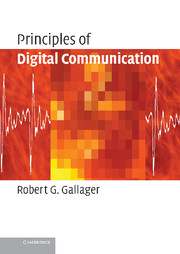Book contents
- Frontmatter
- Contents
- Preface
- Acknowledgements
- 1 Introduction to digital communication
- 2 Coding for discrete sources
- 3 Quantization
- 4 Source and channel waveforms
- 5 Vector spaces and signal space
- 6 Channels, modulation, and demodulation
- 7 Random processes and noise
- 8 Detection, coding, and decoding
- 9 Wireless digital communication
- References
- Index
7 - Random processes and noise
Published online by Cambridge University Press: 05 June 2012
- Frontmatter
- Contents
- Preface
- Acknowledgements
- 1 Introduction to digital communication
- 2 Coding for discrete sources
- 3 Quantization
- 4 Source and channel waveforms
- 5 Vector spaces and signal space
- 6 Channels, modulation, and demodulation
- 7 Random processes and noise
- 8 Detection, coding, and decoding
- 9 Wireless digital communication
- References
- Index
Summary
Introduction
Chapter 6 discussed modulation and demodulation, but replaced any detailed discussion of the noise by the assumption that a minimal separation is required between each pair of signal points. This chapter develops the underlying principles needed to understand noise, and Chapter 8 shows how to use these principles in detecting signals in the presence of noise.
Noise is usually the fundamental limitation for communication over physical channels. This can be seen intuitively by accepting for the moment that different possible transmitted waveforms must have a difference of some minimum energy to overcome the noise. This difference reflects back to a required distance between signal points, which, along with a transmitted power constraint, limits the number of bits per signal that can be transmitted.
The transmission rate in bits per second is then limited by the product of the number of bits per signal times the number of signals per second, i.e. the number of degrees of freedom per second that signals can occupy. This intuitive view is substantially correct, but must be understood at a deeper level, which will come from a probabilistic model of the noise.
This chapter and the next will adopt the assumption that the channel output waveform has the form y(t) = x(t) + z(t), where x(t) is the channel input and z(t) is the noise.
- Type
- Chapter
- Information
- Principles of Digital Communication , pp. 216 - 267Publisher: Cambridge University PressPrint publication year: 2008
- 1
- Cited by



